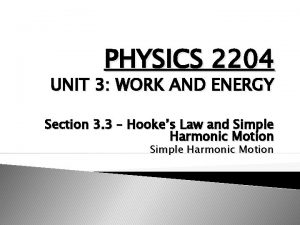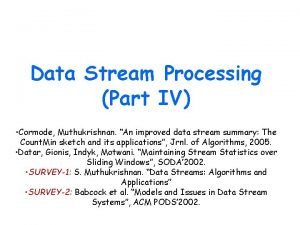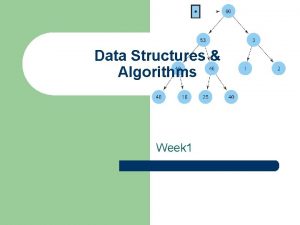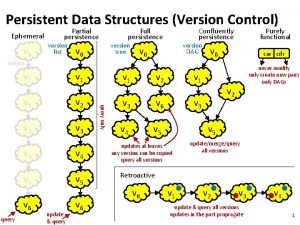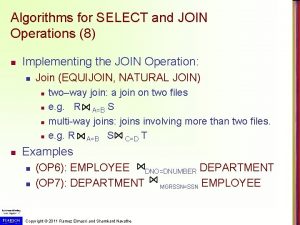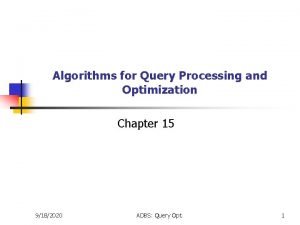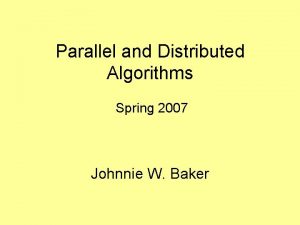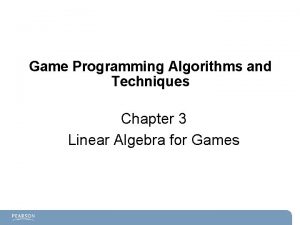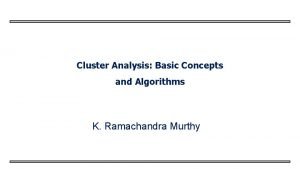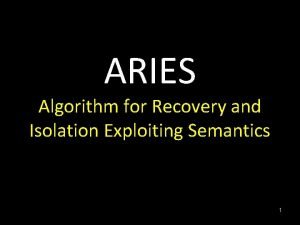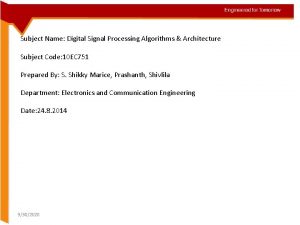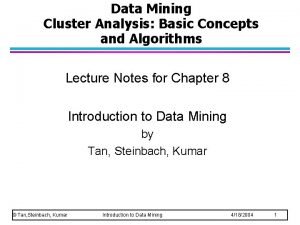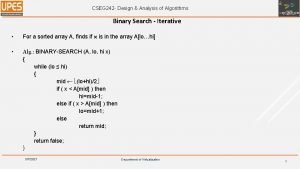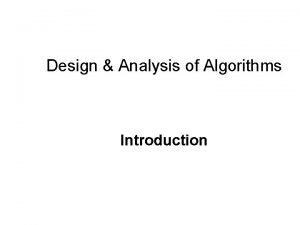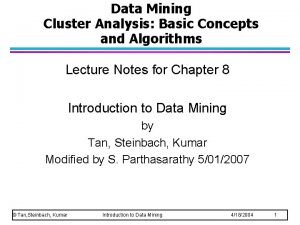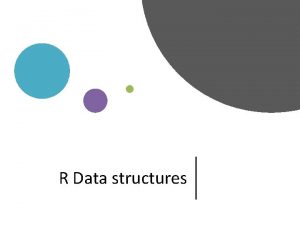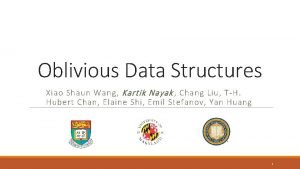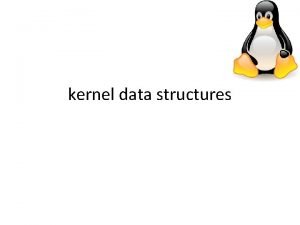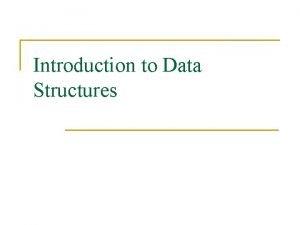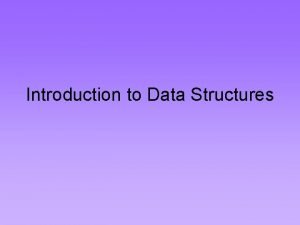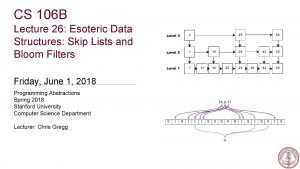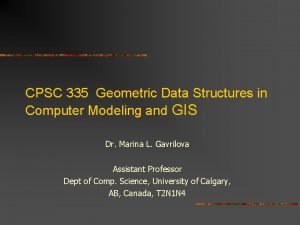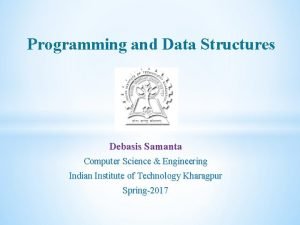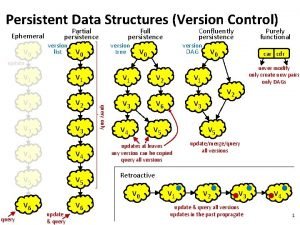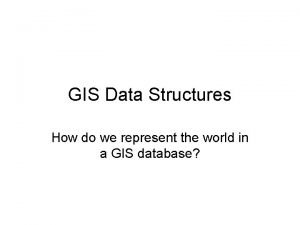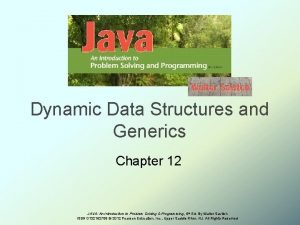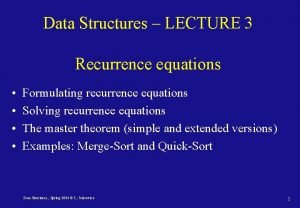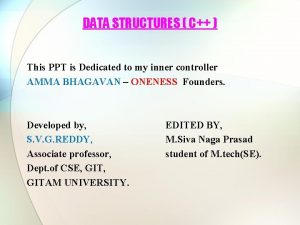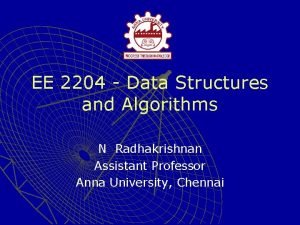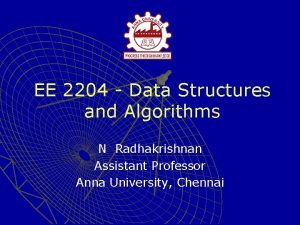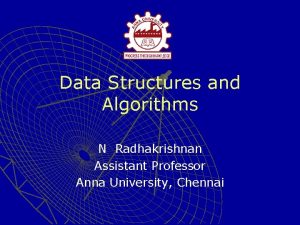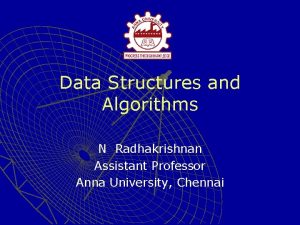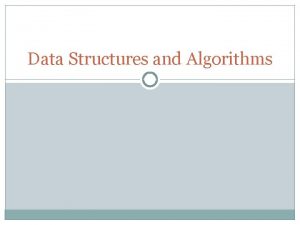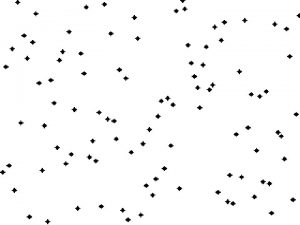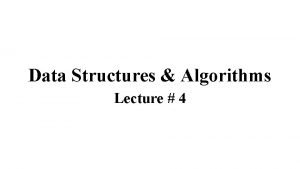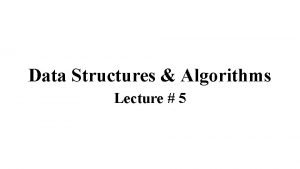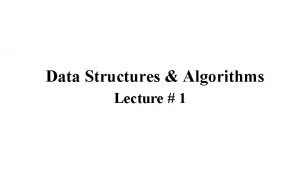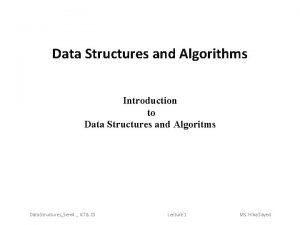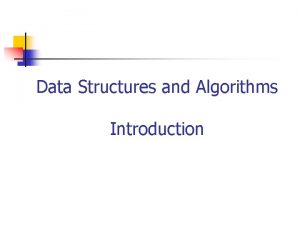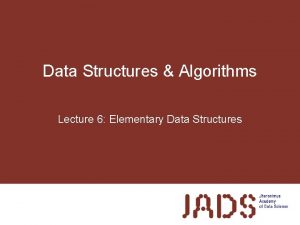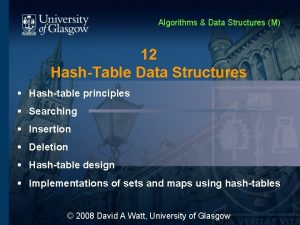EE 2204 Data Structures and Algorithms N Radhakrishnan





















































![Recursive Procedure u TREE-SEARCH(x, k) 1 if x = NIL or k = key[x] Recursive Procedure u TREE-SEARCH(x, k) 1 if x = NIL or k = key[x]](https://slidetodoc.com/presentation_image_h2/8028255a634d49ce2e19077406350e14/image-54.jpg)


![Maximum u u The pseudocode for TREE-MAXIMUM is symmetric. TREE-MAXIMUM(x) 1 while right[x] ≠ Maximum u u The pseudocode for TREE-MAXIMUM is symmetric. TREE-MAXIMUM(x) 1 while right[x] ≠](https://slidetodoc.com/presentation_image_h2/8028255a634d49ce2e19077406350e14/image-57.jpg)

![Tree Successor u TREE-SUCCESSOR(x) 1 2 3 4 5 6 7 6/19/2021 if right[x] Tree Successor u TREE-SUCCESSOR(x) 1 2 3 4 5 6 7 6/19/2021 if right[x]](https://slidetodoc.com/presentation_image_h2/8028255a634d49ce2e19077406350e14/image-59.jpg)












- Slides: 71

EE 2204 - Data Structures and Algorithms N Radhakrishnan Assistant Professor Anna University, Chennai

Topics u Binary Trees • Binary Tree Representations • Binary Tree ADT • Binary Tree Traversals u u u Algebraic Expressions Expression Trees Binary Search Tree • Binary Search Property • Operations on BST 6/19/2021 Anna University, Chennai - 600 025 2

Full and Complete Binary Trees u u A binary tree is said to be full if all its leaves are at the same level and every interior node has two children. A complete binary tree is either a full binary tree or one that is full except for a segment of missing leaves on the right side of the bottom level. 6/19/2021 Anna University, Chennai - 600 025 3

Full and Complete Binary Trees 6/19/2021 Anna University, Chennai - 600 025 4

Full Binary Tree 6/19/2021 Anna University, Chennai - 600 025 5

Complete Binary Tree 6/19/2021 Anna University, Chennai - 600 025 6

Full Binary Trees u u u The full binary tree of height h has l = 2 h leaves and m = 2 h – 1 internal nodes. The full binary tree of height h has a total of n = 2 h+1 – 1 nodes. The full binary tree with n nodes has height h = lg(n+1) – 1. 6/19/2021 Anna University, Chennai - 600 025 7

Complete Binary Tree u In a complete binary tree of height h, h + 1 ≤ n ≤ 2 h+1 – 1 and h = └ lg n ┘ 6/19/2021 Anna University, Chennai - 600 025 8

Make a Note u u u Complete binary trees are important because they have a simple and natural implementation using ordinary arrays. The natural mapping is actually defined for any binary tree: Assign the number 1 to the root; for any node, if i is its number, then assign 2 i to its left child and 2 i+1 to its right child (if they exist. ( This assigns a unique positive integer to each node. Then simply store the element at node i in a[i], where a[] is an array. 6/19/2021 Anna University, Chennai - 600 025 9

Binary Tree Representations u If a complete binary tree with n nodes (depth = log n + 1) is represented sequentially, then for any node with index i, 1 ≤ i ≤ n, we have: • parent(i) is at i/2 if i!=1. If i=1, i is at the root and has no parent. • left. Child(i) is at 2 i if 2 i ≤ n. If 2 i > n, then i has noleft child. • right. Child(i) is at 2 i+1 if 2 i +1 ≤ n. If 2 i +1 >n, then i has no right child. 6/19/2021 Anna University, Chennai - 600 025 10

Array Implementation 6/19/2021 Anna University, Chennai - 600 025 11

The Disadvantage u Figure above shows the incomplete binary tree and the natural mapping of its nodes into an array which leaves some gaps. 6/19/2021 Anna University, Chennai - 600 025 12

Linked List Implementation typedef struct tnode *ptnode; typedef struct tnode { int data; ptnode left, right; }; 6/19/2021 Anna University, Chennai - 600 025 13

Linked List Implementation 6/19/2021 Anna University, Chennai - 600 025 14

Include One more Pointer § A natural way to implement a tree T is to use a linked structure, where we represent each node p of T by a position object with the following fields: § A link to the parent of p, A link to the Left. Child named Left, a link to the Right. Child named Right and the Data. Parent Data Left 6/19/2021 Right Anna University, Chennai - 600 025 15

Array Implementation u Advantages • Direct Access • Finding the Parent / Children is fast u Disadvantages • Wastage of memory • Insertion and Deletion will be costlier • Array size and depth 6/19/2021 Anna University, Chennai - 600 025 16

Linked List Implementation u Advantages • No wastage of memory • Insertion and Deletion will be easy u Disadvantages • Does not provide direct access • Additional space in each node. 6/19/2021 Anna University, Chennai - 600 025 17

Binary Tree ADT u The Binary Tree ADT extends the Tree ADT, i. e. , it inherits all the methods of the Tree ADT, in addition to that it supports the following additional accessor methods: • position left(p): return the left child of p, an error condition occurs if p has no left child. • position right(p): return the right child of p, an error condition occurs if p has no right child. • boolean has. Left(p): test whether p has a left child • boolean has. Right(p): test whether p has a right child 6/19/2021 Anna University, Chennai - 600 025 18

Binary Tree ADT (Cont. ) u u Update methods may be defined by data structures implementing the Binary Tree ADT. Since Binary trees are ordered trees, the iterable collection returned by method chilrden(p) (inherited from the Tree ADT), stores the left child of p before the right child of p. 6/19/2021 Anna University, Chennai - 600 025 19

Binary Tree Traversals u u The three traversal algorithms that are used for general trees (see Chapter 10) apply to binary trees as well: the preorder traversal, the postorder traversal, and the level order traversal. In addition, binary trees support a fourth traversal algorithm: the inorder traversal. These four traversal algorithms are given next. 6/19/2021 Anna University, Chennai - 600 025 20

Level Order Traversal u To traverse a nonempty binary tree: 1. Initialize a queue. 2. Enqueue the root. 3. Repeat steps 4– 7 until the queue is empty. 4. Dequeue a node x from the queue. 5. Visit x. 6. Enqueue the left child of x if it exists. 7. Enqueue the right child of x if it exists. 6/19/2021 Anna University, Chennai - 600 025 21

Level Order 6/19/2021 Anna University, Chennai - 600 025 22

Preorder Traversal u To traverse a nonempty binary tree: 1. Visit the root. 2. If the left subtree is nonempty, do a preorder traversal on it. 3. If the right subtree is nonempty, do a preorder traversal on it. 6/19/2021 Anna University, Chennai - 600 025 23

Preorder 6/19/2021 Anna University, Chennai - 600 025 24

Postorder Traversal u To traverse a nonempty binary tree: 1. If the left subtree is nonempty, do a postorder traversal on it. 2. If the right subtree is nonempty, do a postorder traversal on it. 3. Visit the root. 6/19/2021 Anna University, Chennai - 600 025 25

Postorder 6/19/2021 Anna University, Chennai - 600 025 26

Inorder Traversal u To traverse a nonempty binary tree: 1. If the left subtree is nonempty, do a preorder traversal on it. 2. Visit the root. 3. If the right subtree is nonempty, do a preorder traversal on it. 6/19/2021 Anna University, Chennai - 600 025 27

Inorder 6/19/2021 Anna University, Chennai - 600 025 28

Traversal Using Flag u u The order in which the nodes are visited during a tree traversal can be easily determined by imagining there is a “flag” attached to each node, as follows: To traverse the tree, collect the flags: 6/19/2021 Anna University, Chennai - 600 025 29

Inorder and Postorder 6/19/2021 Anna University, Chennai - 600 025 30

A Simple Application u u A Simple application of trees is to store mathematical expressions in a convenient form. Let's stick for the moment to expressions made up of numbers and the operators +, -, *, and /. We will refer to a tree of this type as an Expression Tree 6/19/2021 Anna University, Chennai - 600 025 31

Algebraic Expressions - Introduction u u u An algebraic expression is a legal combination of operands and operators. Operand is the quantity (unit of data) on which a mathematical operation is performed. Operand may be a variable like x, y, z or a constant like 5, 4, 0, 9, 1 etc. Operator is a symbol which signifies a mathematical or logical operation between the operands. We can write an example of expression as x+y*z. 6/19/2021 Anna University, Chennai - 600 025 32

Algebraic Expressions u u Note the phrase "LEGAL combination" in the definition of an Algebraic Expression, in aforementioned example of expression x+y*z, the operands x , y, z and the operators +, * form some legal combination. Take another example +xyz*, in this expression operators and operands do not make any LEGAL combination; this expression is not a valid algebraic expression. 6/19/2021 Anna University, Chennai - 600 025 33

Algebraic Expressions (2) u An Algebraic Expression can be represented using three different notations: • INFIX: From our school times we have been familiar with the expressions in which operands surround the operator, e. g. x+y, 6*3 etc this way of writing the Expressions is called infix notation. • PREFIX: Prefix notation also Known as Polish notation, is a symbolic logic invented by Polish mathematician in 1920's. In the prefix notation, as the name only suggests, operator comes before the operands, e. g. +xy, *+xyz etc. • POSTFIX: Postfix notation is also Known as Reverse Polish notation. They are different from the infix and prefix notations in the sense that in the postfix notation, the operator comes after the operands, e. g. xy+, xyz+* etc. 6/19/2021 Anna University, Chennai - 600 025 34

Algebraic Expressions (3) u u Now, the obvious question that comes in our mind is, Why use these weird looking PREFIX and POSTFIX notations when we have a sweet and simple INFIX notation? To our surprise INFIX notations are not as simple as they seem specially while evaluating them. To evaluate an infix expression we need to consider Operators' Priority and Associativity. 6/19/2021 Anna University, Chennai - 600 025 35

Algebraic Expressions (3) u u Due to the above mentioned problem of considering operators' Priority and Associativity while evaluating an expression using infix notation, we use prefix and postfix notations. Both prefix and postfix notations have an advantage over infix that while evaluating an expression in prefix or postfix form we need not consider the Priority and Associativity of the operators. Both prefix and postfix notations make Expression Evaluation a lot easier. 6/19/2021 Anna University, Chennai - 600 025 36

How to Represent ? u u Arithmetic expressions can be represented by labeled trees, and it is often quite helpful to visualize expressions as trees. In fact, expression trees, as they are sometimes called, specify the association of an expression’s operands and its operators in a uniform way, regardless of whether the association is required by the placement of parentheses in the expression or by the precedence and associativity rules for the operators involved. 6/19/2021 Anna University, Chennai - 600 025 37

General Idea u u The general idea is that each time we form a larger expression by applying an operator to smaller expressions, we create a new node, labeled by that operator. The new node becomes the root of the tree for the large expression, and its children are the roots of the trees for the smaller expressions. 6/19/2021 Anna University, Chennai - 600 025 38

The Rule u For instance, we can define the labeled trees for arithmetic expressions with the binary operators: • BASIS. A single atomic operand (e. g. , a variable, an integer, or a real) is an expression, and its tree is a single node, labeled by that operand. • INDUCTION. If E 1 and E 2 are expressions represented by trees T 1 and T 2, respectively, then the expression (E 1 + E 2) is represented by the tree of whose root is labeled +. This root has two children, which are the roots of T 1 and T 2, respectively, in that order. 6/19/2021 Anna University, Chennai - 600 025 39

Apply the Rule 6/19/2021 Anna University, Chennai - 600 025 40

Examples 6/19/2021 Anna University, Chennai - 600 025 41

Expression Tree u u Consider the expression 2*3/(2 -1)+5*(4 -1). This expression is made up of two subexpressions, 2*3/(2 -1) and 5*(4 -1), combined with the operator "+". When the expression is represented as a binary tree, the root node holds the operator +, while the subtrees of the root node represent the subexpressions 2*3/(2 -1) and 5*(4 -1). 6/19/2021 Anna University, Chennai - 600 025 42

Expression Tree (2) u u Every node in the tree holds either a number or an operator. A node that holds a number is a leaf node of the tree. A node that holds an operator has two subtrees representing the operands to which the operator applies. The tree is shown in the next Slide. 6/19/2021 Anna University, Chennai - 600 025 43

Expression Tree (3) 6/19/2021 Anna University, Chennai - 600 025 44

Expression Tree - Evaluation u u Given an expression tree, it's easy to find the value of the expression that it represents. Each node in the tree has an associated value. If the node is a leaf node, then its value is simply the number that the node contains. If the node contains an operator, then the associated value is computed by first finding the values of its child nodes and then applying the operator to those values. 6/19/2021 Anna University, Chennai - 600 025 45

Expression Tree – Evaluation (2) u The process is shown by the upward-directed arrows in the illustration. The value computed for the root node is the value of the expression as a whole. There are other uses for expression trees. For example, a postorder traversal of the tree will output the postfix form of the expression. 6/19/2021 Anna University, Chennai - 600 025 46

Expression Tree - Evaluation (3) 6/19/2021 Anna University, Chennai - 600 025 47

Binary Search Trees u u u Search trees are data structures that support many dynamic-set operations, including SEARCH, MINIMUM, MAXIMUM, PREDECESSOR, SUCCESSOR, INSERT, and DELETE. Thus, a search tree can be used both as a dictionary and as a priority queue. One good way to implement a dictionary is with a binary search tree, which is a kind of labeled binary tree. 6/19/2021 Anna University, Chennai - 600 025 48

Binary Search Tree Property u A binary search tree (BST) is a labeled binary tree in which the following property holds at every node x in the tree: • all nodes in the left subtree of x have labels less than the label of x, and all nodes in the right subtree have labels greater than the label of x. This property is called the binary search tree property. 6/19/2021 Anna University, Chennai - 600 025 49

An Example 6/19/2021 Anna University, Chennai - 600 025 50

Some More Examples 6/19/2021 Anna University, Chennai - 600 025 51

Looking Up an Element u u Suppose we want to look for an element x that may be in a dictionary represented by a binary search tree T. If we compare x with the element at the root of T , we can take advantage of the BST property to locate x quickly or determine that x is not present. If x is at the root, we are done. Otherwise, if x is less than the element at the root, x could be found only in the left subtree (by the BST property); and if x is greater, then it could be only in the right subtree (again, because of the BST property). 6/19/2021 Anna University, Chennai - 600 025 52

A Recursive Algorithm u We can express the lookup operation by the following recursive algorithm. • BASIS. If the tree T is empty, then x is not present. If T is not empty, and x appears at the root, then x is present. • INDUCTION. If T is not empty but x is not at the root, let y be the element at the root of T. If x < y look up x only in the left subtree of the root, and if x > y look up x only in the right subtree of y. The BST property guarantees that x cannot be in the subtree we do not search. 6/19/2021 Anna University, Chennai - 600 025 53
![Recursive Procedure u TREESEARCHx k 1 if x NIL or k keyx Recursive Procedure u TREE-SEARCH(x, k) 1 if x = NIL or k = key[x]](https://slidetodoc.com/presentation_image_h2/8028255a634d49ce2e19077406350e14/image-54.jpg)
Recursive Procedure u TREE-SEARCH(x, k) 1 if x = NIL or k = key[x] 2 then return x 3 if k < key[x] 4 then return TREE-SEARCH(left[x], k) 5 else return TREE-SEARCH(right[x], k) 6/19/2021 Anna University, Chennai - 600 025 54

Iterative Procedure u u The same procedure can be written iteratively by “unrolling” the recursion with while loop. [Efficient on most computers] ITERATIVE-TREE-SEARCH(x, k) 1 while x ≠ NIL and k ≠ key[x] 2 do if k < key[x] 3 then x ← left[x] 4 else x ← right[x] 5 return x 6/19/2021 Anna University, Chennai - 600 025 55

Minimum u u An element in a binary search tree whose key is a minimum can always be found by following left child pointers from the root until a NIL is encountered TREE-MINIMUM(x) 1 while left[x] ≠ NIL 2 do x ← left[x] 3 return x 6/19/2021 Anna University, Chennai - 600 025 56
![Maximum u u The pseudocode for TREEMAXIMUM is symmetric TREEMAXIMUMx 1 while rightx Maximum u u The pseudocode for TREE-MAXIMUM is symmetric. TREE-MAXIMUM(x) 1 while right[x] ≠](https://slidetodoc.com/presentation_image_h2/8028255a634d49ce2e19077406350e14/image-57.jpg)
Maximum u u The pseudocode for TREE-MAXIMUM is symmetric. TREE-MAXIMUM(x) 1 while right[x] ≠ NIL 2 do x ← right[x] 3 return x 6/19/2021 Anna University, Chennai - 600 025 57

Successor and predecessor u u u Given a node in a binary search tree, it is sometimes important to be able to find its successor in the sorted order determined by an inorder tree walk. If all keys are distinct, the successor of a node x is the node with the smallest key greater than key[x]. The structure of a binary search tree allows us to determine the successor of a node without ever comparing keys. 6/19/2021 Anna University, Chennai - 600 025 58
![Tree Successor u TREESUCCESSORx 1 2 3 4 5 6 7 6192021 if rightx Tree Successor u TREE-SUCCESSOR(x) 1 2 3 4 5 6 7 6/19/2021 if right[x]](https://slidetodoc.com/presentation_image_h2/8028255a634d49ce2e19077406350e14/image-59.jpg)
Tree Successor u TREE-SUCCESSOR(x) 1 2 3 4 5 6 7 6/19/2021 if right[x] = NIL then return TREE-MINIMUM(right[x]) y ← p[x] while y = NIL and x = right[y] do x ← y y ← p[y] return y Anna University, Chennai - 600 025 59

The Two Cases of TREE-SUCCSSOR u The code for TREE-SUCCESSOR is broken into two cases: • If the right subtree of node x is nonempty, then the successor of x is just the leftmost node in the right subtree, which is found in line 2 by calling TREE-MINIMUM(right[x]). • On the other hand, if the right subtree of node x is empty and x has a successor y, then y is the lowest ancestor of x whose left child is also an ancestor of x 6/19/2021 Anna University, Chennai - 600 025 60

Example u u The successor of the node with key 15 is the node with key 17, since it is the minimum key in the right subtree of 15. The node with key 13 has no right subtree, and thus its successor is its lowest ancestor whose left child is also an ancestor. In this case, the node with key 15 is its successor. 6/19/2021 Anna University, Chennai - 600 025 61

Insertion and Deletion u u u The operations of insertion and deletion cause the dynamic set represented by a binary search tree to change. The data structure must be modified to reflect this change, but in such a way that the binary-search-tree property continues to hold. As we shall see, modifying the tree to insert a new element is relatively straightforward, but handling deletion is somewhat more intricate. 6/19/2021 Anna University, Chennai - 600 025 62

Insertion u u u To insert a new value v into a binary search tree T , we use the procedure TREEINSERT. The procedure is passed a node z for which key[z] = v, left[z] = NIL, and right[z] = NIL. It modifies T and some of the fields of z in such a way that z is inserted into an appropriate position in the tree. 6/19/2021 Anna University, Chennai - 600 025 63

Tree-Insert Procedure u TREE-INSERT(T, z) 1 2 3 4 5 6 7 8 9 10 11 12 13 6/19/2021 y ← NIL x ← root[T] while x ≠ NIL do y ← x if key[z] < key[x] then x ← left[x] else x ← right[x] p[z] ← y if y = NIL then root[T] ← z else if key[z] < key[y] then left[y] ← z else right[y] ← z Anna University, Chennai - 600 025 64

How it Works ? u u The pointer x traces the path, and the pointer y is maintained as the parent of x. After initialization, the while loop in lines 3– 7 causes these two pointers to move down the tree, going left or right depending on the comparison of key[z] with key[x], until x is set to NIL. This NIL occupies the position where we wish to place the input item z. Lines 8– 13 set the pointers that cause z to be inserted. 6/19/2021 Anna University, Chennai - 600 025 65

Tree Insert Operation u u u Inserting an item with key 13 into a binary search tree. Lightly shaded nodes indicate the path from the root down to the position where the item is inserted. The dashed line indicates the link in the tree that is added to insert the item. 6/19/2021 Anna University, Chennai - 600 025 66

Tree Deletion u The procedure for deleting a given node z from a binary search tree takes as an argument a pointer to z. The procedure considers the three cases: • If z has no children, we modify its parent p[z] to replace z with NIL as its child. • If the node has only a single child, we “splice out” z by making a new link between its child and its parent. • Finally, if the node has two children, we splice out z’s successor y, which has no left child and replace z’s key and satellite data with y’s key and satellite data. 6/19/2021 Anna University, Chennai - 600 025 67

Tree Deletion - Case 1 6/19/2021 Anna University, Chennai - 600 025 68

Tree Deletion - Case 2 6/19/2021 Anna University, Chennai - 600 025 69

Tree Deletion - Case 3 6/19/2021 Anna University, Chennai - 600 025 70

Interaction 6/19/2021 Anna University, Chennai - 600 025 71
 Ajit diwan
Ajit diwan Cos 423 princeton
Cos 423 princeton Data structures and algorithms tutorial
Data structures and algorithms tutorial Information retrieval data structures and algorithms
Information retrieval data structures and algorithms Data structures and algorithms bits pilani
Data structures and algorithms bits pilani Ajit diwan
Ajit diwan Data structures and algorithms
Data structures and algorithms Data structures and algorithms
Data structures and algorithms Waterloo data structures and algorithms
Waterloo data structures and algorithms Signature file structure in information retrieval system
Signature file structure in information retrieval system Data structures and algorithms
Data structures and algorithms Manoj radhakrishnan
Manoj radhakrishnan Jai radhakrishnan
Jai radhakrishnan Veena radhakrishnan
Veena radhakrishnan Sarvepalli radhakrishnan
Sarvepalli radhakrishnan Algorithms + data structures = programs
Algorithms + data structures = programs Physics 2204 unit 3: work, power, energy
Physics 2204 unit 3: work, power, energy 2204 b başvuru
2204 b başvuru Tübitak 2204-b proje örnekleri matematik
Tübitak 2204-b proje örnekleri matematik Haldun hadimioglu
Haldun hadimioglu Homology
Homology Stream data model
Stream data model Data structures used in macro processor
Data structures used in macro processor Assembler algorithm and data structures
Assembler algorithm and data structures Data structures and abstractions with java
Data structures and abstractions with java Adts, data structures, and problem solving with c++
Adts, data structures, and problem solving with c++ Data structures and algorithm
Data structures and algorithm Persistent and ephemeral data structures
Persistent and ephemeral data structures Computational thinking algorithms and programming
Computational thinking algorithms and programming Design and analysis of algorithms syllabus
Design and analysis of algorithms syllabus Association analysis: basic concepts and algorithms
Association analysis: basic concepts and algorithms Computer arithmetic: algorithms and hardware designs
Computer arithmetic: algorithms and hardware designs Algorithms for select and join operations
Algorithms for select and join operations Algorithms and flowcharts
Algorithms and flowcharts Undecidable problems and unreasonable time algorithms.
Undecidable problems and unreasonable time algorithms. Cluster analysis: basic concepts and algorithms
Cluster analysis: basic concepts and algorithms Probabilistic analysis and randomized algorithms
Probabilistic analysis and randomized algorithms Design and analysis of algorithms introduction
Design and analysis of algorithms introduction Algorithms for query processing and optimization
Algorithms for query processing and optimization Synchronization algorithms and concurrent programming
Synchronization algorithms and concurrent programming Parallel and distributed algorithms
Parallel and distributed algorithms Lerp
Lerp Cluster analysis basic concepts and algorithms
Cluster analysis basic concepts and algorithms Cjih
Cjih Aries algorithm
Aries algorithm Dsp algorithms and architecture notes
Dsp algorithms and architecture notes Parametric and non parametric algorithms
Parametric and non parametric algorithms Cluster analysis basic concepts and algorithms
Cluster analysis basic concepts and algorithms Binary search in design and analysis of algorithms
Binary search in design and analysis of algorithms Introduction to the design and analysis of algorithms
Introduction to the design and analysis of algorithms Undecidable problems and unreasonable time algorithms
Undecidable problems and unreasonable time algorithms Design and analysis of algorithms
Design and analysis of algorithms Design and analysis of algorithms
Design and analysis of algorithms Cluster analysis basic concepts and algorithms
Cluster analysis basic concepts and algorithms Comp 482
Comp 482 Btechsmartclass.com
Btechsmartclass.com R data structures
R data structures Oblivious data structures
Oblivious data structures Kernel data structures
Kernel data structures Introduction to data structures
Introduction to data structures Introduction to data structures
Introduction to data structures Esoteric data structures
Esoteric data structures Geometric data structures
Geometric data structures What is hadoop i/o
What is hadoop i/o Advanced data structures in java
Advanced data structures in java Classic data structures by debasis samanta ppt
Classic data structures by debasis samanta ppt Persistent vs ephemeral data structures
Persistent vs ephemeral data structures Php data structures
Php data structures What is data structure in gis
What is data structure in gis Linked list java
Linked list java Recurrence data structures
Recurrence data structures Data structures in c ppt
Data structures in c ppt
















